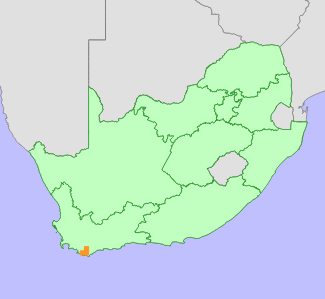|
Scientific Name | Tritoniopsis bicolor J.C.Manning & Goldblatt |
Higher Classification | Monocotyledons |
Family | IRIDACEAE |
National Status |
Status and Criteria | Vulnerable B1ab(ii,iii) |
Assessment Date | 2007/04/12 |
Assessor(s) | P. Goldblatt, J.C. Manning, D. Raimondo & R.C. Turner |
Justification | EOO 120 km², known from less than 10 locations. Threatened by expanding vineyards and invasive alien plants. |
Distribution |
Endemism | South African endemic |
Provincial distribution | Western Cape |
Range | Bredasdorp Mountains. |
Habitat and Ecology |
Major system | Terrestrial |
Major habitats | Overberg Sandstone Fynbos |
Description | Mountain plateaus in seasonally waterlogged flats, growing in deep, humic clay. |
Threats |
| Invasive Alien Species (direct effects), Habitat loss |
Population |
Population trend | Decreasing |
Assessment History |
Taxon assessed |
Status and Criteria |
Citation/Red List version | | Tritoniopsis bicolor J.C.Manning & Goldblatt | VU B1ab(ii,iii) | Raimondo et al. (2009) | |
Bibliography |
Goldblatt, P., Manning, J.C. and Snijman, D. 2005. Cape Plants: corrections and additions to the flora. 1. Bothalia 35(1):35-46.
Manning, J.C. and Goldblatt, P. 2001. Three new species of Tritoniopsis (Iridaceae: Crocoideae) from the Cape region of South Africa. Bothalia 31(2):175-181.
Raimondo, D., von Staden, L., Foden, W., Victor, J.E., Helme, N.A., Turner, R.C., Kamundi, D.A. and Manyama, P.A. 2009. Red List of South African Plants. Strelitzia 25. South African National Biodiversity Institute, Pretoria.
|
Citation |
| Goldblatt, P., Manning, J.C., Raimondo, D. & Turner, R.C. 2007. Tritoniopsis bicolor J.C.Manning & Goldblatt. National Assessment: Red List of South African Plants version 2024.1. Accessed on 2025/12/13 |
 Comment on this assessment
Comment on this assessment


